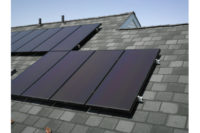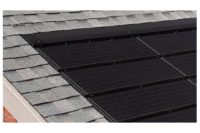At face value, solar energy is a drop in the bucket of global energy sources. By 2020 it will make up just 2 percent of worldwide electricity supply according to Bloomberg New Energy Finance. Yet that is just one side of the coin. A broader view shows that solar is on a bright path as more solar capacity has been installed since 2010 than in the previous four decades. Further, the International Energy Agency (IEA) expects the cost of solar energy to drop significantly in the approaching decades, perhaps justifying the projection that this clean technology will provide 16 percent of the world’s electric power by 2050.
This progress, of course, stems from trial and error. Large-scale acceptance is born project by project. One man’s solar endeavor becomes the showcase for another’s curiosities.
Take John Lister for example. He’s a self-ascribed tech geek, architect nerd and moderate social do-gooder. Last summer he was able to indulge these passions through the reroof of his own home when he opted for a photovoltaic solar roof.
“We’ve had an interest in putting solar on our house for a really long time,” said Lister, who is also the principal of JL Architects of West Chester, Penn.
As a matter of principle, Lister said he’s inclined to pursue projects that look good and are good for the environment. When he designed and built his current home 21 years ago, he made sure energy efficient features like sun shading, the orientation of the house and deep eaves were inherent to its design. An in-law suite was added more recently that included geothermal heating and thermal flooring. So, a solar roof was a natural extension of Lister’s interest in sustainable design.
To get the ball rolling, he connected with Larry O’Donnell, owner of Rooftop Solar Solutions and O’Donnell Roofing Company, each of Haverford, Penn. O’Donnell, whose family has owned the roofing company since 1924, sold and installed the system to Lister.
“My sensitivity to my house may not be like other peoples’. I designed the house. I had it built. I have specific things I like and am very particular about how work gets done. I don’t want someone mucking it up,” Lister said. “O’Donnell’s team did a nice job. They were very respectful and clearly take pride in what they do.”
According to O’Donnell, the original roof needed replacement due to damage from Hurricane Sandy, and it was Lister’s direction that the roofers maintain the original appearance of his home. “He wanted us to make it look as if we were never there,” explained O’Donnell, “and that is just what we did.”
Lister had O’Donnell Roofing Company replace his 6,500 square foot roof with the same style and color of designer asphalt shingle he chose for the original roof—CertainTeed Landmark shingles in the color Colonial Slate. The Landmark shingle is known for providing the dimensional appearance of natural wood shake and meeting industry standards for fire, wind, tear, and wind-driven rain resistance.
In addition, the crew installed 102 CertainTeed Apollo II Solar Roofing panels on the south-facing side of the roof. This system was specified because of its ability to fully integrate with asphalt shingles for a clean, seamless appearance. Plus, the sleek black frame, cells, and back sheet of Apollo II visually blend with surrounding shingles. Lister knew this could not be done with a rack-mounted system.
Concurrent with Lister’s ideals, Apollo II harnesses more energy per square foot than most solar arrays, as its modules come with 14 high-efficiency monocrystalline silicon solar cells for a power rating of 60 watts per module.
From O’Donnell’s point of view, the Apollo II was an easy product for his crew to install. For one, the system easily tied into the Landmark shingles. There was also no need for structural reinforcements or analysis because the panels are as light as asphalt shingles. The panels also allow plenty of open space underneath the modules to make wire installation and maintenance easy. In fact, once work commenced, O’Donnell says it was a quick process.
“We were in and out in three weeks time, including the tear off,” he said.
His crew installed both the Landmark and Apollo II shingles. He subcontracted the electrical work to a trusted electrician who handled the wiring inside the home to convert the photovoltaic system’s collected DC electricity into AC electricity required by the home. A representative from the roofing manufacturer was also on the job during the installation process, which is something O’Donnell appreciated.
“Even though we have been doing solar installations for a number of years, it was nice that CertainTeed had a rep on site. The CertainTeed support team was awesome during the whole process,” said O’Donnell.
Lister’s is the third home in his neighborhood to don a solar roof, though the other homes have larger rack-mounted systems.
“When I look at my roof I like what I see. When I compare mine to the others, I know mine is better. The social responsibility aspect of solar roofing is important to me, but so is curb appeal,” Lister said.
Lister’s roof is just one of the more than 500,000 solar roofs already online in the United States, yet it serves as further evidence that solar acceptance is no longer on a dim path toward possibility, but a brighter path toward acceptance.




